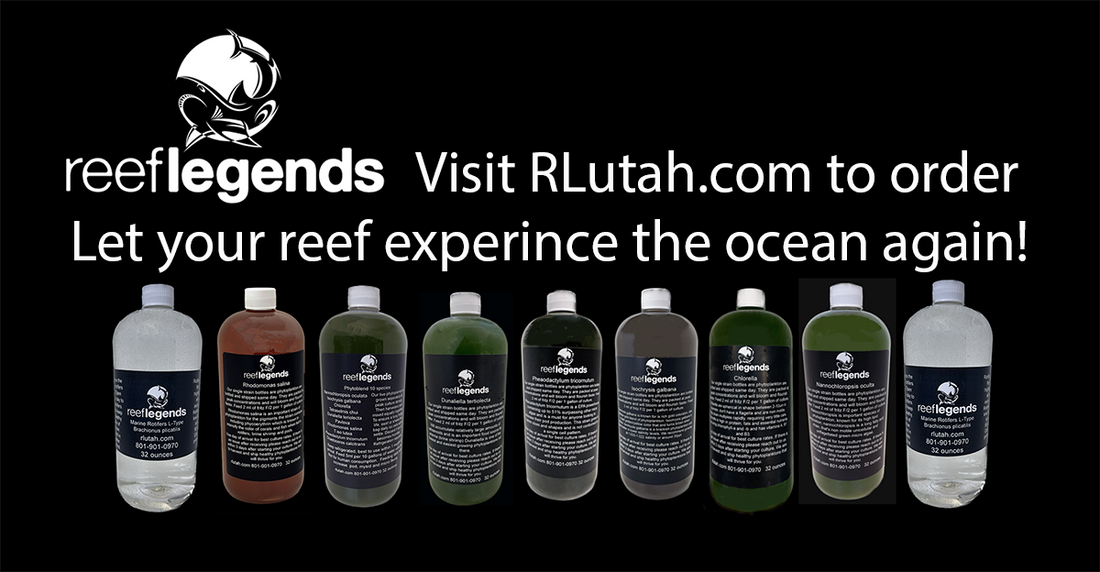
How to feed our Phytoplankton, Rotifers & Pods to your aquarium.
Share
How to feed live marine phytoplankton to your reef aquarium
Feeding live marine phytoplankton to your reef aquarium is relatively simple. It's important to choose a high-quality product that contains a diverse mix of phytoplankton species to ensure optimal nutrition for your reef inhabitants. When buying a diverse mix of phytoplankton, it is important to store and use the product within 3-4 weeks and keep the bottle inside a refrigerator away from the light.
Once you have our live marine phytoblend, start by feeding 5 mls per 10 gallons of aquarium water volume. Turn off your return pump, wait 2-5 minutes and dose the desired amount, wait 30 minutes to 2 hours before turning your return pump on. Please make sure you have your wave makers going to carry the phytoplankton around your reef aquarium. Monitor the response of your corals and other filter-feeding organisms. You can dose more than the recommended amount, be careful as you can remove more nitrate, phosphate and silicates than you think.
If the color changes after arrival, begins to smell foul please discard the bottle and do not feed any longer.
How to feed live marine L type rotifers to your reef aquarium.
When feeding our live marine rotifers, each bottle is bottled with our live phytoblend. Once you receive your package, open the bottle by removing the lid, placing in a refrigerator and using the bottle within 3 weeks of arrival. Our rotifers are package the day of shipping, if the water inside the bottle goes clear or light yellow color, top off with a little phytoblend, allowing the rotifers to stay enriched and alive.
Feeding recommendations; remove bottle from refrigerator, twist lid back on the bottle, invert the bottle to help mix the rotifers back into the water column and feed 5-20mls per 10 gallons of water volume. Turn off your return pump, wait 2-5 minutes and dose the desired amount, wait 30 minutes to 2 hours before turning your return pump on. Please make sure you have your wave makers going to carry the live rotifers around your reef aquarium.
How to add live marine copepods to your reef aquarium.
When you receive your copepods, we recommend waiting till your lights are off on your reef aquarium. Turning off your return pump and wave makers for 2-5 minutes before adding the bottle(s) to your reef aquarium. Rinse bottle with aquarium water to remove all copepods that may be left in the bottle. Leave your return pump and wave makers off for 30-60 minutes before turning your return pump and wave makers back on. This allows ample time for your copepods to settle inside your aquarium.
Our Phytoblend mixture contains the following.
Our in house blend of single phytoplankton cultures combined at peak concentrations and never diluted. This blend has everything you could ask for! Contains the following phytoplanktons:
Green phytoplanktons (Nannochloropsis oculata,Tetraselmis chui, Chlorella, Dunaliella tertiolecta)
Golden phytoplanktons (Tisochrysis lutea, Pavlova, Isochrysis galbana, Thalassiosira weissfloggii)
Red phytoplankton (Rhodomonas salina)
Orange phytoplankton (Chaetocerors calcitrans)
Brown phytoplanktons (Pheaodactylum tricornutum)
This is an exceptional mix of phytoplanktons that will make your corals feel like they are back in the ocean. If the color changes or begins to smell, please discard the bottle before using again.
What is Live Marine Phytoplankton?
If you're a reef aquarium enthusiast, you've probably heard about the benefits of feeding live marine phytoplankton to your tank. But what exactly is it? Live marine phytoplankton refers to a diverse group of microscopic algae that float in the ocean. These tiny organisms are the foundation of the marine food chain and play a crucial role in maintaining the health of coral reefs.
Why Should You Feed Live Marine Phytoplankton to Your Reef Aquarium?
Feeding live marine phytoplankton to your reef aquarium can have numerous benefits. First, it provides a natural and nutritious food source for your corals, clams, and other filter-feeding organisms. Live marine phytoplankton is rich in essential nutrients, including vitamins, minerals, and amino acids, which are vital for the growth and vitality of your reef inhabitants.
Secondly, live marine phytoplankton helps to improve water quality in your aquarium. These tiny algae absorb excess nutrients, such as nitrates, phosphates and silicates, which can lead to poor water quality and algae blooms. By introducing live marine phytoplankton into your tank, you can help maintain a healthy balance of nutrients and reduce the risk of algae overgrowth.
The Benefits of Feeding Live Marine Phytoplankton
By incorporating live marine phytoplankton into your reef aquarium feeding routine, you can expect to see several benefits. Your corals and other filter-feeding organisms will thrive, displaying vibrant colors and enhanced growth. The water quality in your tank will improve, with reduced levels of nitrates, phosphates and silicates. This, in turn, will help prevent algae overgrowth and promote a healthier, more balanced ecosystem.
Furthermore, feeding live marine phytoplankton can also enhance the overall biodiversity of your reef aquarium. Phytoplankton serves as a natural food source for a variety of organisms, including copepods and other zooplankton. These small creatures, in turn, become a valuable food source for fish and other marine life in your tank, creating a more dynamic and self-sustaining ecosystem.
Conclusion
Feeding live marine phytoplankton to your reef aquarium is a simple yet effective way to boost the health and vitality of your tank. By providing a natural and nutritious food source, you can ensure that your corals and other filter-feeding organisms thrive. Additionally, the introduction of live phytoplankton helps to improve water quality and promote a more balanced ecosystem. So why wait? Start incorporating live marine phytoplankton into your reef aquarium feeding routine and watch your tank flourish!
